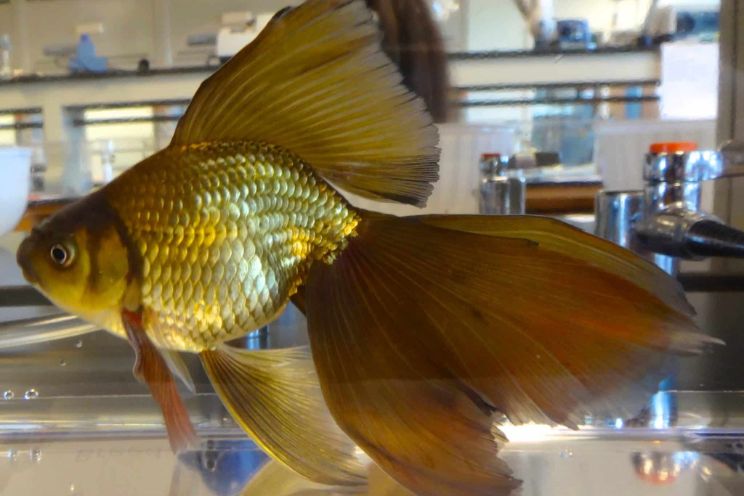Veiltail goldfish are an unusual, seldom-seen variety of Fancy goldfish that can make beautiful pets.
These delicate goldfish can be challenging to care for, so can you keep Veiltails in a community setup? How many Veiltais can live in the same tank? Are Veiltails aggressive fish?
Read on to learn what fish can make the best Veiltail goldfish tank mates.

What size tank does a Veiltail goldfish need?
Veiltail goldfish are a type of Fancy goldfish. These beautiful fish usually grow to measure from 6 to 7 inches in length, not including their luxuriant tail fins. That means you’ll need a pretty big tank to comfortably fit a couple of Veiltails and a few tank mates.
When you buy your goldfish from a pet store or aquarium shop, you’ll most likely find that the fish on sale are tiny, 1-inch-long specimens. But don’t be fooled!
Those cute fishies will quickly grow, provided you feed them a high-quality, balanced diet and keep them in a roomy tank.
For that reason, we recommend that you start with a large tank of a minimum of 20 to 30 gallons or more. That saves you the hassle and expense of having to upsize your tank a few months after getting your fish home.
You should also note that you need to add a further 10 gallons to your tank size for every extra goldfish you want to add to your community.
Messy fish!
Although buying such a large tank for what are really pretty small fish might seem like overkill, goldfish of all varieties are extremely messy creatures, continually depositing waste into your tank as they swim around.
Unlike most other fish species, the goldfish doesn’t have a stomach. Any food the fish eats simply passes straight through the fish’s intestines where the nutritional content is extracted. The leftover waste is passed out of the fish and into the water, quickly polluting the environment.
Although goldfish are relatively hardy creatures, they cannot tolerate high levels of ammonia and nitrates in their environment.
Poor water quality stresses the fish, causing outbreaks of common diseases, including Velvet and Ich, meaning that your fish won’t thrive. So, you must not overcrowd your aquarium, and you also need to run an efficient filter system that’s powerful enough to cope with the amount of waste produced by the fish.

What tank shape is best for Veiltail goldfish?
Veiltail goldfish are round-bodied, Fancy goldfish with extravagant long fins. While that certainly makes them one of the most beautiful goldfish varieties, that finnage also makes swimming somewhat difficult for the fish.
Ideally, you want to choose a long, rectangular tank that offers lots of open swimming space for the fish while allowing them to easily swim to the surface to feed.
That tank shape is also the best choice for efficient gaseous exchange. Goldfish are oxygen-hungry fish, so plenty of dissolved oxygen in the water is essential for their health.
Again, a cramped environment with low oxygen levels will stress the fish, potentially leading to disease outbreaks, stunted growth, and a general failure to thrive.
- Never keep Veiltail goldfish in a tank that’s too small or overcrowded.
Tank hoods and cover slides
Adult Veiltail goldfish are not physically able to jump, largely due to their heavy tails and fat body shape. However, juvenile specimens can be flighty and might jump when startled and when you’re carrying out routine maintenance tasks on your tank.
So, we recommend that you use a tank with a lid or cover slide to prevent accidents.
A lid also keeps dust and foreign objects from falling into the water and minimises evaporation.
Goldfish bowls?
Although when we were kids, most of us associated goldfish with life in a traditional goldfish bowl, those containers are now regarded as obsolete.
In fact, many vets regard the use of goldfish bowls as inhumane for several reasons:
- A goldfish bowl is too small for an adult goldfish and doesn’t provide sufficient swimming space for the fish’s needs.
- The surface area provided by a bowl is insufficient for good gaseous exchange, potentially leading to a lack of dissolved oxygen in the water.
- Goldfish bowls are not suitable for the installation of an efficient filter system. Goldfish are dirty fish, and a powerful filter is essential to maintain good water quality.
Goldfish are sociable fish that should live in groups. A bowl is too small to accommodate more than one fish.
You should not keep goldfish in a goldfish bowl!
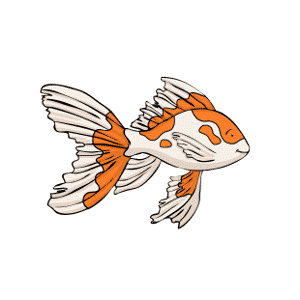
Can Veiltail goldfish live in a garden pond?
Theoretically, you can keep Veiltail goldfish in a garden pond. However, there are a few reasons why we recommend that you don’t.
- Fancy goldfish, such as Veiltails, prefer slightly warmer water than slim-bodied types. So, Shubunkins and Comets do very well in an outdoor pond, even when the water temperature drops to around freezing. However, Fancies will struggle in such cool water, especially if you live in an area where the winters are very cold.
- Veiltail goldfish are not good swimmers and will probably be buffeted and barged out of the way at feeding times by larger, more agile swimmers. That can lead to stress, disease, and even starvation in extreme cases.
- Veiltails are quite delicate and are more prone to injury than many other Fancy goldfish types and can easily be injured during feeding frenzies.
All that said, you can still keep Veiltails successfully in a large, sheltered pond exclusively with their own kind if you live in a warm region.

Are Veiltail goldfish aggressive toward other fish?
Veiltail goldfish are not aggressive toward other fish, including other goldfish.
All goldfish are highly social creatures that love to spend time with other fish, and they can become highly stressed if forced to live alone. In fact, in some countries, such as Switzerland, it’s illegal to keep one goldfish on its own.
However, goldfish can appear feisty sometimes, especially during spawning.
At that time, male goldfish will chase a female around the tank, pushing her against decorations, plants, and the viewing panes in an attempt to trigger egg laying.
Juvenile goldfish recently introduced to a new tank or pond often chase each other. That’s usually just part of the acclimation process, and the fish typically settle down after a few days of getting used to their new environment.
Can Veiltail goldfish live with tropical fish?
Goldfish are coldwater fish, so you might think that they can’t live with tropical species. However, a few tropical fish can do well in more temperate conditions and can do very well in a community with Veiltail goldfish.
Basically, if you have a fish tank with a stable temperature of over 70° Fahrenheit, you should be able to include a few tropical fish in a community with your Veiltail goldfish.
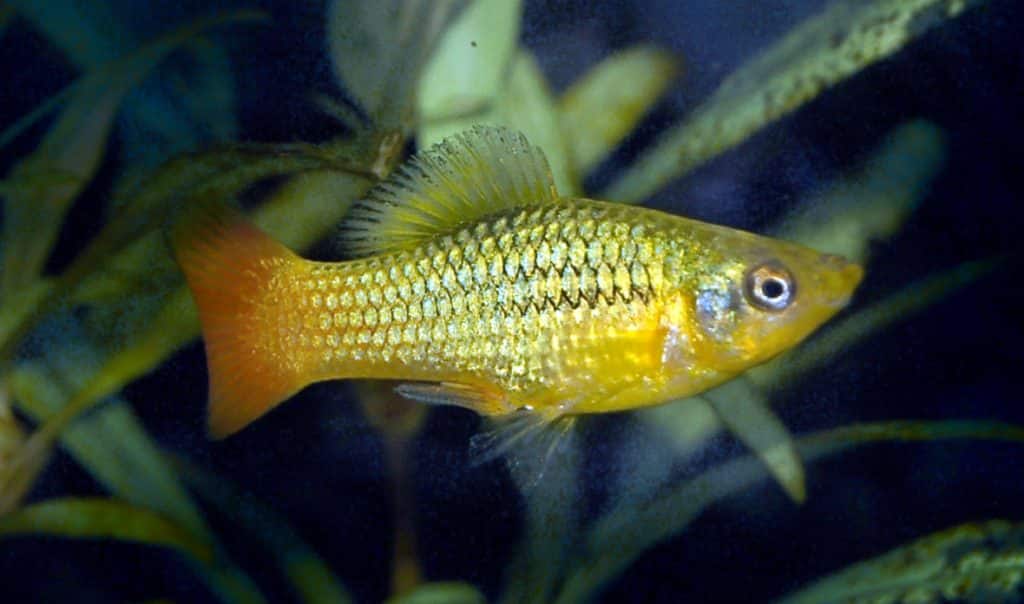
Platies
Platies are a popular species of livebearer that are easy to care for, peaceful community fish.
These brightly-colored fish grow to around 3 inches in length, so are too big for a hungry goldfish to eat. Platies are prolific breeders, quickly producing large numbers of fry. But that’s not usually a problem since your Veiltails will quickly gobble up most of the fry that appears.
However, a few baby Platies will probably survive in a well-planted tank.
River Murray Rainbowfish
River Murray Rainbowfish are beautifully colourful tropical fish that do extremely well in water temperatures of around 70° Fahrenheit.
In fact, these easy-care fish produce their most vibrant colours when kept in cooler water, adding a shimmering, glittering rainbow effect to your aquarium.
Rosy Barbs
Barbs have a reputation for being aggressive fish, and that’s certainly true of some species.
However, Rosy barbs are peaceful schooling fish that need to live in a minimum 30-gallon tank since they can grow to 6 inches long when mature.
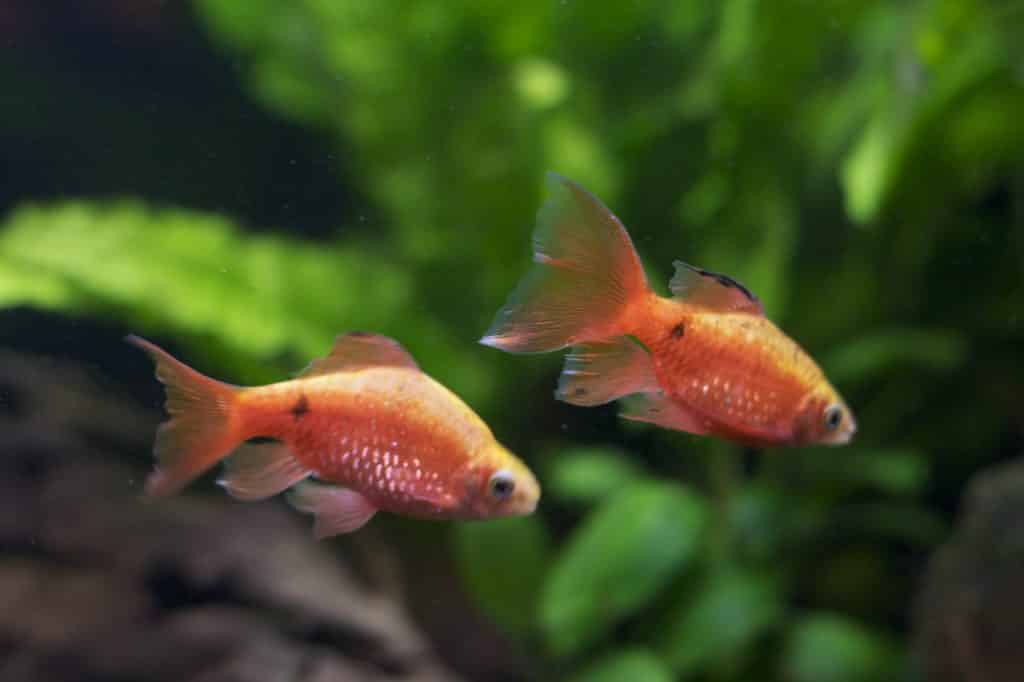
Checkered barbs
Like Rosy barbs, Checkered/Chequered barbs make a pleasing addition to a mixed cold water tank. These fish are peaceful, shoaling types that generally grow to around 2 inches in length.
Note that you must keep Checkered barbs in groups of at least six fish for them to thrive and be happy.
White Cloud Mountain Minnows
White Cloud Mountain minnows are an extremely popular choice for hobbyists wanting to add a temperate species to a coldwater goldfish tank.
You need to keep these minnows in big schools in a well-planted aquarium that features lots of hardscapes where the fish can hide when they need to.
Zebra Danios
Zebra danios are tiny, striped shoaling fish that love cool water of between 65° to 77° Fahrenheit, making them an ideal choice for a community tank with Veiltail goldfish.
A large group of these pretty little fish looks beautiful, darting amid dense planting in a large tank.
Weather Loach
The weird Weather loach is also known as the Dojo loach.
These loaches are nocturnal, bottom-dwellers, so you won’t see much of them unless you have a moonlight setting on your tank lighting unit. Weather loaches react violently to changes in barometric pressure, darting around the tank in agitation, and that’s what gives them their name.
If you decide to add Dojos to your setup, bear in mind that these strange fish can climb and will escape through the smallest hole or gap in your tank lid. These fish need a large tank of at least 55 gallons to be happy.
Corydoras Catfish
Corydoras catfish are everyone’s favourite bottom-dwellers. These cute little fish are super-easy to care for, living on the substrate and spending most of their day scavenging or darting up to the water’s surface.
With over 100 different types of Corys to choose from, you’re sure to find something to take your fancy. These fish range in size from 1 to 3 inches in length and need to live in groups of at least five individuals.
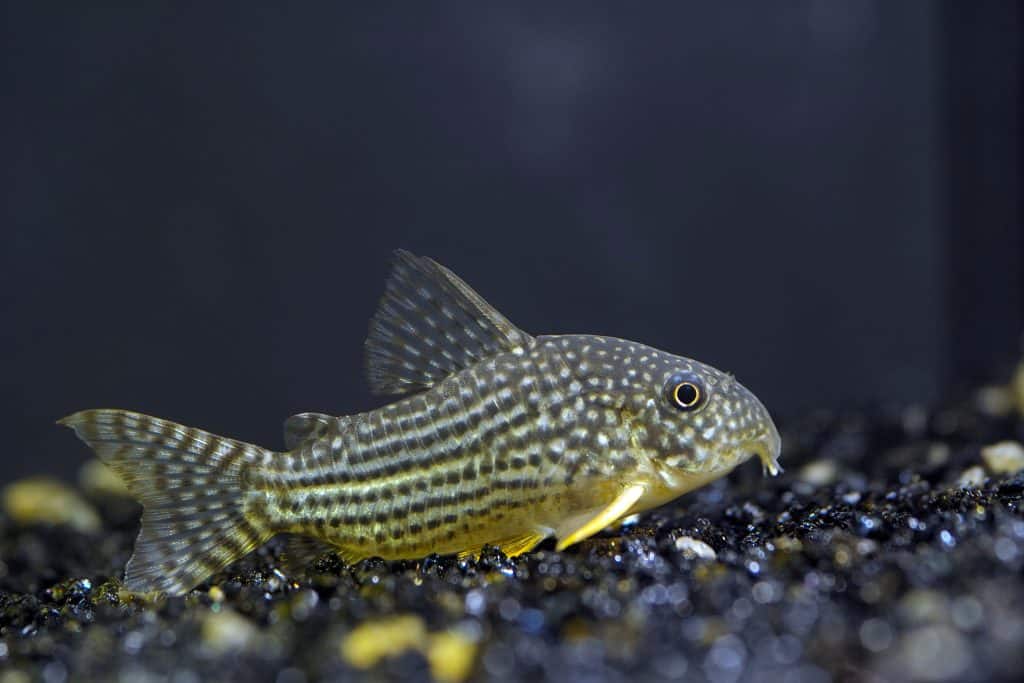
Hillstream Loach
Hillstream loaches thrive in cooler water temperatures from 68° to 75°F.
Unlike many other loach species, Hillstreams are diurnal. However, you most likely won’t see much of these guys, as they prefer to stay hidden under driftwood and rocks or amid thick planting.

Best tank mates for Veiltail goldfish
Tropical fish are not to everyone’s taste, and you might prefer to stick to keeping goldfish with your Veiltails.
That’s not a problem, as there are plenty of goldfish varieties to choose from that will all do very well in a community tank with Veiltails.
Any of the following Fancy goldfish types can make suitable tank mates for Veiltails:
- Tamasaba
- Ryukin
- Ranchu
- Pearlscale
- Oranda
- Lionhead
- Lionchu
- Dragon Eye
- Celestial Eye
- Butterfly Telescope
- Butterfly Tail
- Fantail
To add variety to your aquarium, you might want to consider keeping a few invertebrates in your community setup.
Snails can do very well with goldfish since both species tend to leave each other alone. However, shrimp can be regarded as lunch by the goldfish and are therefore best avoided.
As an added bonus, snails can provide a useful cleaning service in that they eat organic waste and plant debris, helping to keep the environment tidy.
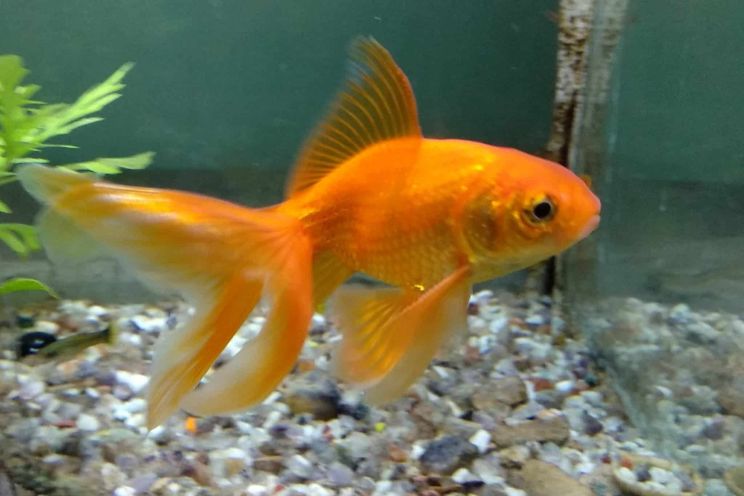
Unsuitable tank mates for Veiltail goldfish
As mentioned above, we recommend that you don’t keep slim-bodied goldfish and fast swimmers with Veiltails. Very small fish and tiny shrimp species should also be avoided, as they could be eaten.
Veiltails have long, extravagant finnage so should not be kept with any species that has a reputation as a fin nipper.

How many fish should Veiltail goldfish live with?
Like all fish species, Veiltails must live with other fish to thrive and be happy. So, that means you can keep your Veiltail goldfish with as many other fish as you have tank space to accommodate.
That said, be very careful that you don’t overcrowd your fish. If you cram too many fish of any species into a tank that’s too small for them, the fish will become stressed.
Stress causes a lowered immune system, leading to disease outbreaks, parasite attacks, and an overall lack of condition.
If you keep goldfish in a tank that’s too small, the fish often fail to develop and grow properly, often suffering from deformities and other physical abnormalities.
A crowded tank can also cause problems at feeding times because the largest fish tend to push the smaller ones out of the way. That means the weaker fish don’t get the food they need to thrive and grow. The resultant stress often causes even more problems, and in extreme cases, some fish might even starve.
Final Thoughts
Did you enjoy our guide to the best Veiltail goldfish tank mates? If you found the article helpful, please share it before you go!
Veiltails are friendly, sociable goldfish that need to live in large groups in a spacious tank with similar Fancy goldfish types or suitable tropical fish species. We advise that you don’t keep small shrimp species with goldfish, as these little invertebrates can finish up on the fish’s menu.
Fast swimmers, such as Comets and Shubunkins are best avoided to prevent competition at feeding times and injury to the slower Veiltails.
Do you keep Veiltail goldfish? What tank mates do you keep with them? Tell us about your fishy friends in the comments box below.
